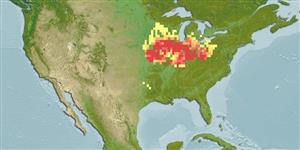Classification / Names
Common names from other countries
Main reference
Size / Weight / Age
Max length : 221 cm TL male/unsexed; (Ref. 5723); common length : 120 cm TL male/unsexed; (Ref. 12193); max. published weight: 90.7 kg (Ref. 3221); max. reported age: 55 years (Ref. 46974)
Environment
Freshwater; demersal; potamodromous (Ref. 51243); depth range 2 - ? m
Climate / Range
Temperate; 10°C - 18°C (Ref. 2060), preferred ?; 50°N - 30°N
Distribution
North America: Mississippi River system, including the Missouri River into Montana, the Ohio River, and their major tributaries. At least one country reports adverse ecological impact after introduction. International trade restricted (CITES II, since 11.6.92).
Countries | FAO areas | Ecosystems | Occurrences | Introductions
Short description
Snout long, canoe-paddle-shaped; gill cover with large, fleshy, pointed flap (Ref. 86798).
IUCN Red List Status (Ref. 115185)
Human uses
Fisheries: commercial; aquarium: public aquariums
Tools
Special reports
Download XML
Internet sources
Estimates of some properties based on models
Phylogenetic diversity index
PD50 = 1.2500 many relatives (e.g. carps) 0.5 - 2.0 few relatives (e.g. lungfishes)
Trophic Level
3.4 ±0.45 se; Based on food items.
Resilience
Low, minimum population doubling time 4.5 - 14 years (tm=6-9; tmax=30)
Vulnerability
Very high vulnerability (85 of 100)
Price category
